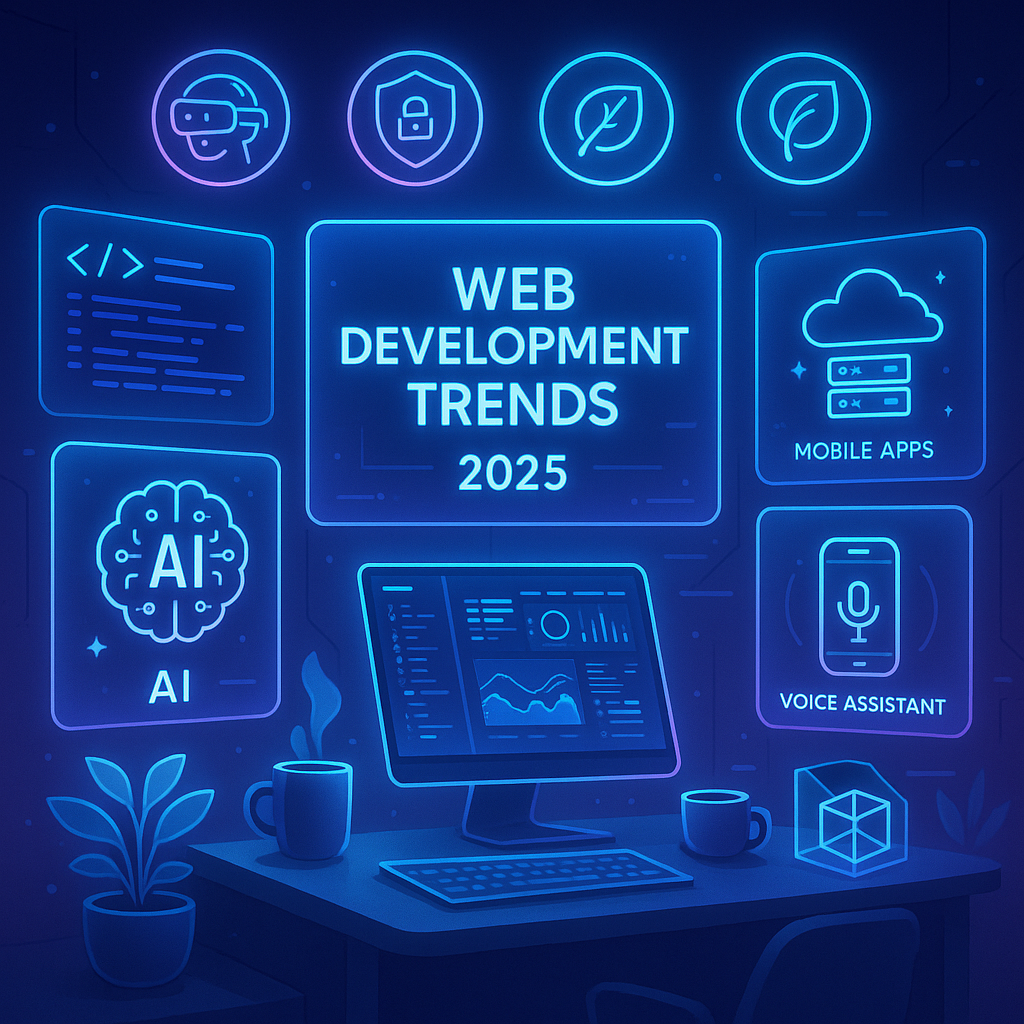Introduction
The digital landscape is moving at lightning speed. In 2025, web development is set to evolve in ways that will shape how we build, interact with, and experience websites. From AI-driven personalization to sustainable design, the latest trends highlight innovation, accessibility, and performance.
Are you wondering what web development trends to watch in 2025? Let’s explore the 15 key shifts that will define the future of websites and applications.
1. Progressive Web Apps (PWAs)
PWAs continue to dominate by combining the best of mobile apps and traditional websites. They work offline, load instantly, and deliver app-like experiences without downloads.
Why it matters in 2025: With mobile-first browsing at its peak, PWAs will be critical for brands seeking higher engagement and conversions.
2. AI-Powered Development & Personalization
AI isn’t just for chatbots—it’s reshaping coding, testing, and personalized user experiences. Developers now rely on AI-driven tools for faster builds and tailored interfaces.
Why it matters in 2025: Smarter automation means reduced workload for developers and hyper-personalized content for users.
3. AI-Generated Content & Video
AI-powered videos and dynamic content creation will scale faster than ever. Businesses will use AI to craft product explainers, tutorials, and even interactive video experiences.
Why it matters in 2025: Personalized video will become a key driver of customer engagement.
4. Voice Search Optimization & Voice UX
With the rise of smart speakers and voice assistants, optimizing websites for natural language is no longer optional. Voice User Interfaces (VUIs) will simplify accessibility.
Why it matters in 2025: More users will search by asking questions aloud—sites optimized for conversational queries will gain a competitive edge.
5. Serverless Architecture & Edge Computing
Serverless solutions let developers build without managing infrastructure, while edge computing reduces latency by processing data closer to the user.
Why it matters in 2025: Faster, scalable, and cost-efficient sites will become the new norm.
6. API-First & Headless CMS
Headless CMS and API-first designs allow content to flow seamlessly across devices, from smartwatches to AR applications.
Why it matters in 2025: Brands need omnichannel readiness—and headless CMS makes that possible.
7. Jamstack & Microservices Architecture
Breaking apps into modular microservices and using Jamstack improves performance and scalability.
Why it matters in 2025: Businesses will gain faster load speeds, tighter security, and easier upgrades.
8. WebAssembly (Wasm)
WebAssembly makes high-performance coding possible in browsers, enabling near-native speeds for heavy applications like video editing or gaming.
Why it matters in 2025: Expect more complex, browser-based apps without slowdowns.
9. Motion UI & Micro-Interactions
Micro-animations and interactive feedback enhance usability and keep users engaged longer.
Why it matters in 2025: Motion-driven design ensures smooth, memorable experiences.
10. Dark Mode & Mobile-First Responsive Design
Dark mode is no longer just aesthetic—it reduces eye strain and conserves battery life. Combined with mobile-first responsiveness, it ensures accessibility.
Why it matters in 2025: Comfort and inclusivity drive user satisfaction.
11. Augmented Reality (AR), Virtual Reality (VR), and 3D Web
Immersive 3D shopping and interactive VR experiences are transforming industries like retail, real estate, and education.
Why it matters in 2025: Expect AR/VR to become standard in e-commerce and learning platforms.
12. Sustainable / Green Web Design
Developers are embracing eco-friendly practices like lightweight code, efficient hosting, and green UX principles.
Why it matters in 2025: Sustainability isn’t optional—users and regulators demand greener digital experiences.
13. Enhanced Cybersecurity & Privacy
Cyber threats are rising, and so is the demand for multi-factor authentication, AI-driven monitoring, and encrypted frameworks.
Why it matters in 2025: Stronger privacy builds trust and protects brand reputation.
14. Low-Code / No-Code Platforms
These platforms empower non-developers to build apps quickly, speeding up prototyping and democratizing web creation.
Why it matters in 2025: Businesses can scale digital solutions without waiting on long dev cycles.
15. Web Augmentation & Conversational Interfaces
Web augmentation tools and overlays enhance browsing experiences, while conversational interfaces bring intuitive, human-like interactions.
Why it matters in 2025: The web becomes more adaptive and personalized for each visitor.
Conclusion
The future of web development in 2025 is about speed, intelligence, accessibility, and sustainability. From AI-powered personalization to green coding practices, these 15 trends reveal that the web is moving toward smarter, more immersive, and user-centric experiences.
👉 Which trend will transform your next project? Staying ahead means adapting now.
FAQs
What are PWAs and why are they important in 2025?
Progressive Web Apps (PWAs) combine the best of apps and websites, offering fast, offline-ready, app-like experiences. They’re essential as mobile-first usage dominates in 2025.
How does serverless architecture improve web apps?
It removes the need to manage servers, cutting costs and improving scalability while reducing latency when paired with edge computing.
How do I make my website voice-search friendly?
Use conversational keywords, structured data, and FAQs that match natural language queries like “What’s the best web development trend in 2025?”

